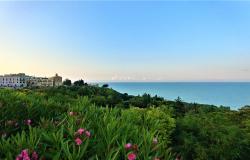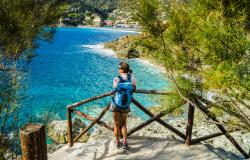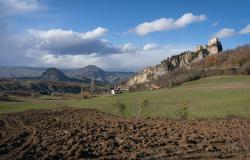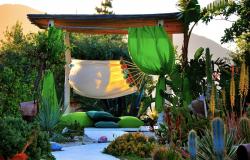Rock striations in a Dolomite mountain group conserve the history of geological periods from the demise of the dinosaurs to the age of the modern mammal, say earth scientists.
A series of mountain chains in the Dolomite range have a rock strata succession from the Early Jurassic to the Late Triassic geological epochs, offering a record of the entire period represented in the Dolomites according to surveys by the International Union for the Conservation of Nature (IUCN).
The Dolomiti Friulane-Dolomits Furlanis and d'Oltre Piave group is the fourth of nine mountain groups included in Italy's bid for its famous Dolomite mountain range to become a World Heritage Site.
Both Italian and Ladin are spoken in the Dolomites between the regions of Trentino Alto Adige and Veneto, accounting for the Friuli chain's double-barrelled name.
The IUCN, the World Heritage Committee's technical advisory body on natural heritage, approved Italy's application in May - a significant step in the nomination process.
Created by the United Nations Educational, Scientific and Cultural Organization (UNESCO) in 1972, the World Heritage Committee was created to protect cultural and natural heritage of outstanding universal value.
Nine groups of mountains in the Dolomite range are part of the bid to join other cultural and natural wonders on the United Nations World Heritage List.
Italy has based the serial application on two UNESCO criteria for natural sites - unique evidence of geological processes and exceptional natural beauty.
The World Heritage Committee is expected to make its ruling by the end of June.
The Dolomiti Friulane-Dolomits Furlanis and d'Oltre Piave group is a series of chains running north to south with an apparently straightforward rock strata succession dominated by dolomite-calcareous rocks; however, three major tectonic lines and repeated striations due to faulting complicate the geology in these mountains.
More than half the mountain group is made up of Dolomia Principale from the late Triassic period; the fragmented rock in the strikingly beautiful Cellina Valley was deposited during the Cretaceous and Palaeocene-Eocene epochs.
This easternmost group in the application spans a total of 21,460 hectares including three provinces and two regions: Belluno in the Veneto region and Pordenone and Udine in the FriuliVenezia Giulia region.
The mountains rise between the Piave and Tagliamento valleys, the Val Tramontina, and the middle of the Val Cellina where the Cellina River canyon winds, collecting water from its two largest tributaries, the Cimoliana and the Settimana.
The main groups and highest peaks from north to south are the Cridola (2,581 metres), the Monfalconi (Cima Monfalconi, 2,548 metres), the Spalti di Toro (Cadin di Toro, 2,386 metres) and the Duranno-Cima Preti (2,706 metres).
The Val Montanaia, with its famous 300-metre 'Bell Tower', is the best-known alpine area in the Friuli Dolomites Regional Park.
The 2,173 metre 'Campanile' towers over the Spalti del Toro and Montefalconi, the largest array of peaks, pinnacles and spikes in the Dolomites.
Standing on its own in a natural amphitheatre, the tower was first climbed by Austrian mountaineers Victor Wolf von Glanvell and Karl von Saar on September 17, 1902 just ten days after an attempt by two climbers from Trieste, Napoleone Cozzi and Alberto Zanutti.
Forced to turn back short of the summit, the Italians were able to furnish the Austrians with enough information for them to complete a successful ascent. The Friuli and d'Oltre Piave Dolomites make up one of the wildest - and best conserved - areas in the entire range and are the least impacted by tourism and human development.
Much of this fourth group benefits from environmental protection measures established in the Conservation and Development Plan drafted by local authorities in the late 1980s which led to the creation of the Friuli Dolomiti Alps Regional Natural Park in 1996.
A popular entrance to the park is through the untamed landscape in the Val Cellina where a route dug out by ancient glaciers has been turned into a bike path leading to the visitors centre in Cimolais.






